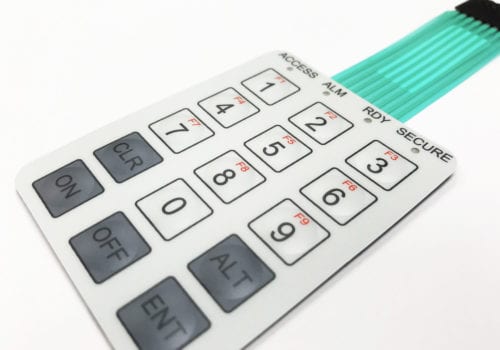Recognizing the Performance of Membrane Changes for User User Interface Instruments
The performance of membrane layer changes stands for a substantial innovation in individual interface style, incorporating efficiency with aesthetic convenience. These switches operate with a multi-layered structure that translates customer interactions into electric signals, permitting both portable layouts and strength versus ecological elements. As industries significantly focus on user experience, comprehending the nuances of membrane layer button modern technology ends up being essential. What ramifications do these advancements hold for future applications, and exactly how might they redefine customer communications throughout various tools?
What Are Membrane Buttons?
Membrane switches are ingenious user interface gadgets that assist in user communication with electronic tools. These versatile components include several layers, consisting of a graphic overlay, spacer, and a printed circuit layer. The design permits for a seamless combination into numerous electronic gadgets, boosting both the visual and functional facets of customer interfaces.
Membrane switches are frequently utilized in a large variety of applications, from household home appliances to commercial equipment and clinical devices. Their building and construction typically includes a slim account, making them a perfect selection for small layouts. The tactile comments provided by these switches can be engineered to meet details individual preferences, making sure effective communication in between the individual and the gadget.
Sturdiness is an additional significant advantage of membrane layer buttons, as they are resistant to dust, dampness, and chemicals, which improves their lifespan sought after settings. In addition, these switches can be customized in terms of form, dimension, and visuals design, enabling for branding and user-specific features. On the whole, membrane layer changes represent a practical solution for improving user experience in electronic tools, incorporating functionality with visual charm in an effective way.
Exactly How Membrane Switches Job
Operating on a simple principle, membrane layer switches over utilize a layered building to sign up customer input successfully. Each switch contains numerous layers, including a printed circuit layer, a spacer layer, and a leading visuals layer, which are designed to function with each other flawlessly. When an individual presses the top layer, it compresses the spacer layer, bringing the conductive aspects of the circuit layer right into contact with each other.
This contact develops a shut circuit, signifying the device to implement a particular feature. The design enables different arrangements, including tactile responses, which can boost the user experience by providing a physical feeling upon activation. The materials used in membrane buttons often include versatile substratums, such as polyester or polycarbonate, which guarantee durability and durability versus deterioration.

Key Benefits of Membrane Layer Switches

Another considerable benefit is their compactness. Membrane buttons are slim and lightweight, which allows manufacturers to save space in their devices without compromising capability. This function is specifically useful in applications where weight and quantity are Full Article vital considerations.
In addition, membrane buttons are immune to dirt, wetness, and chemicals, enhancing their sturdiness. This resilience expands their life-span and reduces find out here the need for constant replacements, resulting in cost savings over time.
Moreover, the responsive responses offered by membrane layer switches can be optimized to improve individual communication. They can include attributes such as raised switches or audible clicks, boosting functionality and customer experience.
Applications Throughout Industries
Interface gadgets making use of membrane switches prevail in a wide variety of sectors, showcasing their versatility and functionality. Membrane Switch. In the medical sector, membrane buttons are essential to gadgets such as diagnostic tools and client tracking systems, where their resilience and ease of cleaning are essential for keeping health standards. In the auto market, these switches are utilized in dashboard controls and infomercial systems, giving a smooth and modern-day user interface for customers.
In addition, the customer electronics industry gain from membrane switches in home appliances and portable tools, where portable design and straightforward interfaces boost individual experience. Industrial applications additionally take advantage of membrane layer switches over for control board in machinery and automation systems, highlighting their robustness and resistance to harsh settings.
In the aerospace and defense industries, membrane switches are used in cockpit weblink controls and tools, where reliability and efficiency under severe problems are critical. Additionally, the gaming market progressively includes membrane switches in controllers and game equipments, adding to an interesting individual experience. Generally, the flexibility of membrane layer switches enables their prevalent use across various fields, highlighting their value in contemporary interface layout.
Future Patterns in Membrane Switch Over Modern Technology

Furthermore, making use of sophisticated products, such as polycarbonate and polyester films, is expected to climb, providing improved toughness and resistance to environmental stress factors. These products add to the total long life of membrane layer buttons, making them appropriate for harsher commercial applications.
Furthermore, the consolidation of clever technology, including IoT connectivity, will allow membrane layer switches to communicate with various other gadgets and systems, assisting in a much more interactive individual experience. This fad lines up with the expanding demand for wise devices throughout numerous markets, from medical care to customer electronics.
Lastly, modification alternatives are prepared for to expand, allowing producers to develop bespoke solutions tailored to details user demands and preferences. These advancements will position membrane layer buttons as essential components in the evolution of interface technology.
Conclusion
In final thought, membrane layer switches over represent a critical improvement in user interface technology, supplying a dependable and flexible remedy for diverse electronic applications. As developments in product scientific research and touch sensing innovations continue, the functionality and applicability of membrane switches are expected to broaden, reinforcing their relevance in modern electronic tools.